Decision-makers have often been tasked to undertake complex decisions, involving uncertain environments regulated by socio-economic, ecological, governance and several other determinants. In this rapidly changing climate scenario, the need to assess all potential risks is more crucial than ever. Hence, Climate Risk Assessment (CRA) serves as a tool to facilitate the decision-making process and to address climate emergency.
Given its ability to provide a near real scenario, CRA can give a clear understanding of potential climate risk impacts across ecosystems at national/state/regional/local level. Both state and non-state actors can deploy CRA before the implementation of a project/programme or they can deploy the same for assessing the adaptive measures to potential risks posed by hazards.
While, CRAs are generally viewed as a complex technical subject, the core of CRA studies comprise of qualitative and/or quantitative estimation of three main pillars i.e. Hazards, Exposure and Vulnerability (refer image below and refer to definitions here [1]).
Source: IPCC AR5
As per the latest IPCC Sixth Assessment Report [1], Climate risk is defined as the potential for adverse consequences for human or ecological systems, recognising the diversity of values and objectives associated with such systems. In the context of climate change, risks can arise from potential impacts of climate change as well as human responses to climate change. Relevant adverse consequences include those on lives, livelihoods, health and well-being, economic, social and cultural assets and investments, infrastructure, services (including ecosystem services), ecosystems and species.
In milieu of climate change impacts, these risks are a result of dynamic interactions between climate-related hazards with the exposure and vulnerability of the affected human or ecological system to the hazards. Hazards, exposure and vulnerability, each may be subjected to uncertainty in terms of magnitude and likelihood of occurrence, and may vary over time and space due to socio-economic changes and human decisions.
From the perspective of climate change responses, risks can result from potential responses and may not achieve the intended objective(s), either from potential trade-offs with, or from negative side-effects on, other societal objectives, such as the Sustainable Development Goals (SDGs). Any uncertainty in implementation, effectiveness or outcomes of climate policy, climate-related investments, technology development or adoption, and system transitions can also give rise to risks.
IORA, a leading environmental consultancy in India, has implemented 100+ projects in the area of natural resource conservation, climate change mitigation and adaptation. With multi-disciplinary expertise in finance, policy advisory, scientific research, project design and implementation, IORA has served as technical advisor to government and private sector entities for over a decade. Our solutions on climate change, energy and healthy forests are being implemented across 10 million hectares in 27 states and 2 UTs of India, wherein we have been providing location-specific analysis of risks with detailed assessment of systems exposed to those hazards and enabling appropriate climate action. We work primarily on Nature based Solutions to deliver multiple cross-sectoral benefits, while protecting and enhancing the natural capital that provides these benefits.
Our team is currently revising the State Action Plan on Climate Change (referred to as SAPCC) for Maharashtra, Assam and Arunachal Pradesh among the others. These updated SAPCCs will provide strategic actions and targets at the district level for duration of 2021-2030, as per the common guidelines laid by the Ministry of Environment, Forests, and Climate Change (MoEFCC- GoI).
As part of the SAPCCs, we have also undertaken a multi-step CRA to identify key focus areas in each district. Our first step involves performing a detailed indicator-based vulnerability assessment at the district level for sectors including agriculture, water resources and health. Supporting the vulnerability assessment, a comprehensive analysis of observed climate and climate projections (RCP 2.5 and RCP 8.5[2]) of extreme events is undertaken consecutively. Next, evidence-based climate impacts backed with the ground expertise of the state line department officials are added to list of key districts. Lastly, all the highlighted districts are overlaid as per the vulnerability assessment, climate analysis, and exposure (using impact evidence assisted the members from state line department and the team drafting the SAPCCs to visualise and identify the focus districts). This process showcases that the complex climate risk assessment can be simplified with the right approach and methodology to support decision-makers. Also, it simplifies the process of building long-term actions based on scientific evidence, which further strengthens the decisions.
Thus, a transition to informed climate risk decisions is a key pathway during the decade of action to build resilience. Considering the fact that climate risks are unevenly distributed and are generally greater for disadvantaged people and communities in nations at all levels of development, CRAs will enhance and help achieve all sustainable development and Paris Goals in future.
[1] As per IPCC AR5: RCP – Representative Concentration Pathway
[2] Glossary of IPCC AR6 WGI Report: https://www.ipcc.ch/report/ar6/wg1/#FullReport







